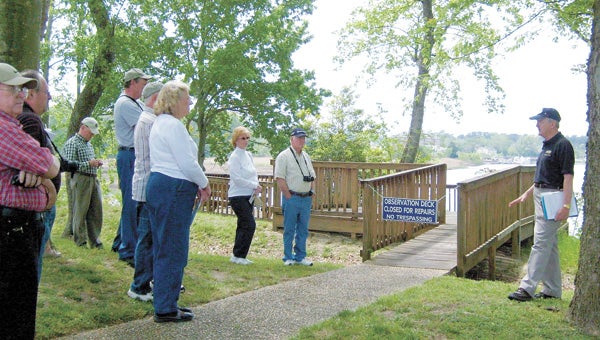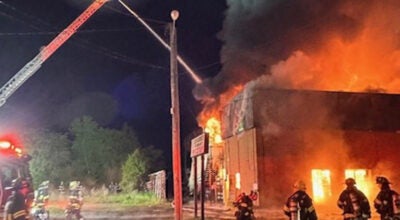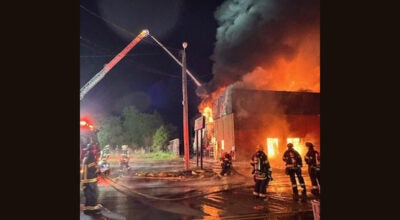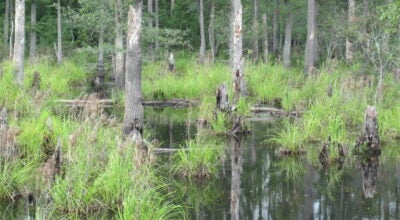Tours unearth Civil War history
Published 9:36 pm Monday, April 1, 2013

Kermit Hobbs guides a group around Suffolk Civil War battlefields during a tour last year. Hobbs will be guiding bus tours again this Saturday, when, as well as on Sunday, the Suffolk Nansemond Historical Society will also present tours of Cedar Hill Cemetery.
When people think of Virginia’s Civil War sites, they’re more likely to envision Appomattox, Petersburg or Fredericksburg. But Suffolk has an interesting array of battlefields, says a man who’ll lead a tour around them this Saturday.
Kermit Hobbs, a 69-year-old current member and past president of the Suffolk Nansemond Historical Society, has an abiding interest in local sites.
“I used to play in the trenches when I was a kid,” he said. “I didn’t know where they came from until I grew older and learned how to do the research. I got the history behind them. The enthusiasm bit me then, and it’s been with me pretty much all my life.”
Though he has been the annual spring bus tour’s guide for a decade, Hobbs said he has actually been showing people the battlefields and teaching their history for nearly 50 years.
The morning tour will leave the Suffolk Seaboard Station Railroad Museum, 326 N. Main St., at 10 a.m., returning at noon, and the afternoon tour departs from the same spot at 1 p.m., getting back around 4 to 4:30 p.m.
The morning tour will head first to the site of Battery Onandaga, which Hobbs said offers a panoramic view of Civil War activity in Suffolk.
Fort Connecticut, near the Route 58 bypass, will be next, followed by the site of the Battle of Deserted House, where the opposing sides fought a battle early on Jan. 30, 1863.
Other sites will be added if time permits, but the last scheduled stop in the morning is the home site of Judith Kilby Smith, the only civilian casualty in the Siege of Suffolk.
The Battery Onandaga site will also start the afternoon tour, which will then move on to Fort Stevens, a Union earthwork overlooking the Nansemond River, as well as Fort Huger, across the river from Fort Stevens and where Union forces successfully launched an amphibious attack on the Confederates.
Tour-goers will venture on to Fort Rosecrans, which Hobbs says is as impressive as any fort.
“It’s well-preserved, and the embankments are pretty high,” he said. “It’s very impressive to see it; you can see where the cannons sat on the parapets and where the cannons rolled up.”
The afternoon tour will involve a lot of walking through woods, and Hobbs advised participants to bring comfortable shoes and insect repellent. Water will be provided and a rest stop at Nansemond River Golf Club is scheduled.
Tickets for the morning tour are $12 for society members or $15 for non-members, and $13 and $17, respectively, in the afternoon.
Meanwhile, the society will also present tours of historic Cedar Hill Cemetery on Saturday and Sunday, from 2 p.m. to 3 p.m. Tickets cost $5 for members and $6 for non-members. Sue Woodward will be the guide, and costumed characters from 1863 will speak at various points along the way.
Society board member and local attorney Fred Taylor will be one of the costumed characters. He described those buried on the grounds of the cemetery as “a who’s who of Suffolk history, both from local leaders — the men who made this town — all the way down to farmers and blue-collar workers.”
A century and a half after the Civil War, the society is working to educate the public about what life was like then for Suffolk citizens, Taylor said. “We’re talking from the perspective of local civilians who were here at the time.”
One Suffolk citizen with an interesting story was Judith Kilby Smith’s brother, who represented Suffolk and Nansemond County at the secession conventions, Taylor said.
“Kilby remained fairly strongly Unionist, and he abstained from the vote,” Taylor said, adding that when an overwhelming majority voted for secession, he was one of about four men who changed their votes on the official record to support the Confederacy.
“He felt that if his fellow members had chosen to secede, he would stand behind them,” he said. “It just took him a little bit to get there.”
To book a spot or add your name to the waiting list for any tour, call society headquarters on 539-2781 on Tuesday or Wednesday, or leave a message any other day.






